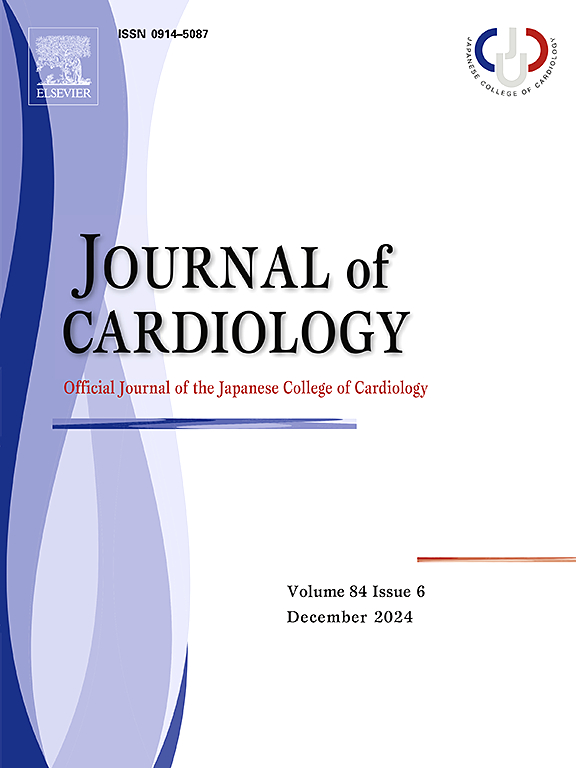Usefulness of exercise stress echocardiography for predicting cardiovascular events and atrial fibrillation in hypertrophic cardiomyopathy
IF 2.5
3区 医学
Q2 CARDIAC & CARDIOVASCULAR SYSTEMS
引用次数: 0
Abstract
Background
In hypertrophic cardiomyopathy (HCM), the determinants of exercise tolerance and the usefulness of exercise stress echocardiography (ESE) for predicting hard endpoints have not been fully investigated. We aimed to assess the key parameters of ESE for exercise tolerance and the factors predictive of cardiovascular events and new-onset atrial fibrillation (AF) in patients with HCM.
Methods
Seventy-four consecutive patients with HCM who underwent ESE and with an ejection fraction ≥50 % were enrolled. The primary endpoint was a composite of cardiovascular death, heart failure hospitalization, ventricular fibrillation or tachycardia, and ventricular assist device implantation. The secondary endpoint was new-onset AF.
Results
The primary endpoint occurred in 13 patients. The left and right ventricular functions during exercise were responsible for decreased exercise tolerance. Peak exercise e′ and tricuspid annular plane systolic excursion (TAPSE) significantly predicted increased primary outcome risk (hazard ratio 1.35, 95 % confidence interval 1.10–1.76, p = 0.003; hazard ratio 1.19, 95 % confidence interval 1.07–1.32, p = 0.002, respectively), and the results were consistent even after adjustment by maximum workload. These ESE parameters improved the prognostic model containing estimated glomerular filtration rate (eGFR) and left atrial (LA) volume index. In AF-naive patients (n = 58), LA volume, peak exercise LA reservoir strain, and left ventricular outflow tract (LVOT) pressure gradient predicted new-onset AF.
Conclusions
In patients with HCM, ESE parameters related to left and right ventricular function were responsible for low exercise tolerance. Furthermore, e′ and TAPSE at peak workload could be useful for predicting cardiovascular events in addition to eGFR and LA volume index. LVOT pressure gradient and LA function during exercise predicted new-onset AF.

运动负荷超声心动图在预测肥厚型心肌病心血管事件和心房颤动方面的实用性。
背景:在肥厚型心肌病(HCM)患者中,运动耐量的决定因素以及运动负荷超声心动图(ESE)在预测硬终点方面的作用尚未得到充分研究。我们的目的是评估 ESE 运动耐量的关键参数以及预测 HCM 患者心血管事件和新发房颤(AF)的因素:74例连续接受ESE治疗且射血分数大于50%的HCM患者被纳入研究。主要终点是心血管死亡、心衰住院、心室颤动或心动过速和心室辅助装置植入的复合终点。次要终点是新发房颤:13名患者达到了主要终点。运动时左心室和右心室功能导致运动耐量下降。运动峰值e'和三尖瓣环面收缩期偏移(TAPSE)可显著预测主要结局风险的增加(危险比分别为1.35,95%置信区间为1.10-1.76,p = 0.003;危险比分别为1.19,95%置信区间为1.07-1.32,p = 0.002),即使根据最大工作量进行调整后,结果也是一致的。这些 ESE 参数改善了包含估计肾小球滤过率(eGFR)和左心房(LA)容积指数的预后模型。在未发生房颤的患者(58 人)中,LA 容积、运动峰值 LA 储能应变和左心室流出道(LVOT)压力梯度可预测新发房颤:结论:在 HCM 患者中,与左心室和右心室功能相关的 ESE 参数是导致低运动耐量的原因。此外,除了基线时的 eGFR 和 LA 容积指数外,峰值负荷时的 e' 和 TAPSE 也可用于预测心血管事件。运动时左心室出口压力梯度和 LA 功能可预测新发房颤。
本文章由计算机程序翻译,如有差异,请以英文原文为准。
求助全文
约1分钟内获得全文
求助全文
来源期刊

Journal of cardiology
CARDIAC & CARDIOVASCULAR SYSTEMS-
CiteScore
4.90
自引率
8.00%
发文量
202
审稿时长
29 days
期刊介绍:
The official journal of the Japanese College of Cardiology is an international, English language, peer-reviewed journal publishing the latest findings in cardiovascular medicine. Journal of Cardiology (JC) aims to publish the highest-quality material covering original basic and clinical research on all aspects of cardiovascular disease. Topics covered include ischemic heart disease, cardiomyopathy, valvular heart disease, vascular disease, hypertension, arrhythmia, congenital heart disease, pharmacological and non-pharmacological treatment, new diagnostic techniques, and cardiovascular imaging. JC also publishes a selection of review articles, clinical trials, short communications, and important messages and letters to the editor.
 求助内容:
求助内容: 应助结果提醒方式:
应助结果提醒方式:


